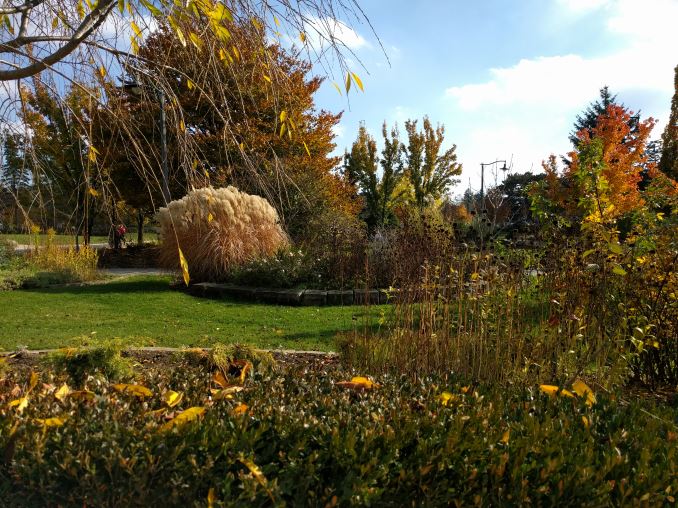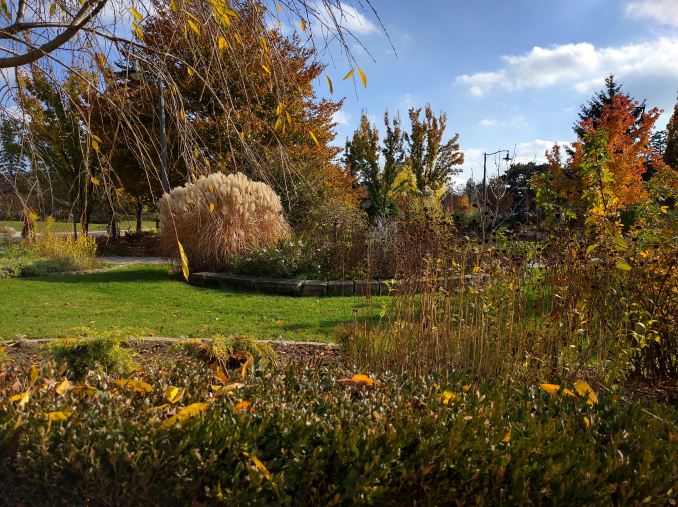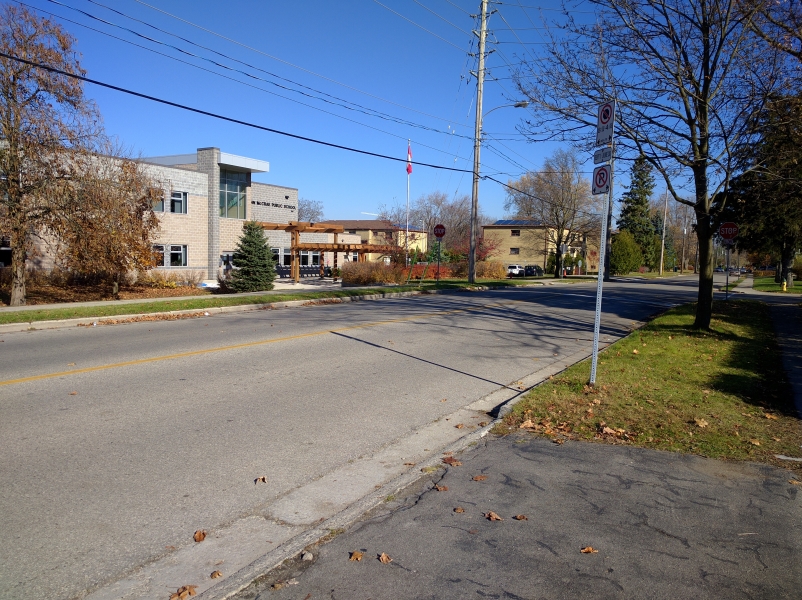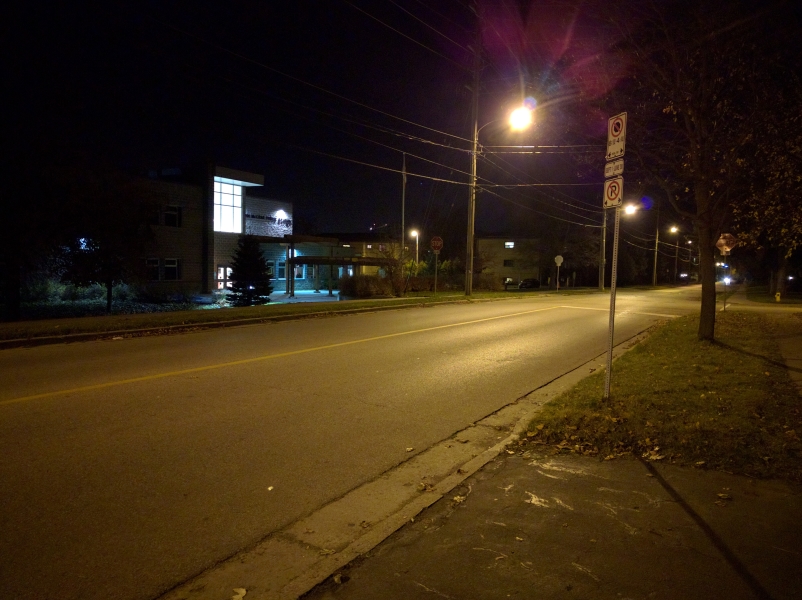The Google Nexus 5X Review
by Brandon Chester on November 9, 2015 8:00 AM EST- Posted in
- Smartphones
- LG
- Mobile
- Android 6.0
- Nexus 5X
The Effect of HDR+
HDR+ is a camera feature that originally launched on the Nexus 5. HDR+ is more like tone mapping from multiple images, which doesn't give you the dramatic contrast between dark and light that you sometimes get from HDR modes. What I've found interesting is that many statements from users say that using the HDR+ mode significantly improves the appearance and the exposure of their photos. I would actually agree with this based on my experience with the Nexus 6, but the problem in that case was that each HDR+ shot took multiple seconds to process which is simply unacceptable. This delay was even longer on the Nexus 5, which presents a problem with trying to just keep HDR+ on constantly to improve photo quality.
On the Nexus 5X, my observation has been that the camera often takes an incorrect exposure. I've displayed a sample comparison above, and while you have to take my word for it, the HDR+ shots are usually much more like what I actually saw when I took the photos. Most notably, the 5X would usually blow out the sky if it was even remotely bright out, while the HDR+ mode maintained a sky that was sometimes a bit too deep blue, but much better than the searing white of the overexposed shots. The normal images also seemed to tend toward a green white balance.
Of course, this presents a bit of a problem if we assume that HDR+ shots take a significant amount of time to process. It would mean that you're either stuck with waiting a long time between shots, or dealing with inaccurate colors and an overall incorrect exposure. Fortunately, you don't really need to make this choice, because software improvements bundled with Snapdragon 808's ISP improvements over Snapdragon 800 and 805 mean that HDR+ photos only take a second at most to be captured and processed. This means that you can just leave the HDR+ toggle on and take your photos.
To be honest, even though HDR+ mode improves the exposure, it's not really acceptable that Google is resorting to heavy processing and merging multiple exposures just to achieve a proper exposure. Relative to the single millisecond exposure time for a daytime photo, the second between shots to process the HDR+ photos is quite a long period of time. In addition, the lack of OIS means that even with Google's shifting and cropping of the exposures to account for blur you still run the risk of introducing blurriness into the photos due to the longer exposure time, especially when lighting is decent but not amazing and the exposures can take up to 100 milliseconds each.
For the purposes of these photo comparisons, HDR+ was generally left on, although non HDR+ versions are also included for reference. While this is somewhat unfair to the devices being compared, the true purpose of these sections is to give an idea of how well a camera performs with some relevant context in the form of comparison images from related and competing smartphones, rather than to just slot a phone somewhere in a list of the best smartphone cameras.
Still Image Quality
While we don't have a completely controlled test for examining a smartphone's image quality, a surprising amount of information can be gained just by comparing the photos taken by different smartphones in the same circumstances. I've taken test images on the Nexus 5X at my typical photo location during both the day and at night. Due to changing seasons I've had to retake my comparison images, and going forward there may be some phones or tablets that are no longer in the comparison due to the device samples being returned.
| Daytime Photography |
In my daytime test scene the Nexus 5X performs very well. In the HDR+ image much of the foliage actually shows an increase in detail compared to the Nexus 6, and the pavement doesn't have the unnatural texture that it does in the Nexus 6's image, which is a good sign of Google improving their processing and toning down the sharpening. The HDR+ mode definitely has a more accurate exposure than the standard mode, but both are not as close to what the scene actually looked like as the Nexus 6 and Galaxy S6 Edge. However, there are some other factors to be considered, and with them I think the Nexus 5X actually provides the best image quality of the devices in this comparison.
The first point is detail. Even with a lower sensor resolution, the sharpness and detail of the various trees and branches is much greater on the Nexus 5X than the Nexus 6. The second is distortion, and this is where the Galaxy S6 Edge runs into issues. Anything that is at all close to the left and right sides of the frame in the Galaxy S6's image is blurry and distorted, which includes the tree on the far left and anything to the right of the closest stop sign on the right. While I was concerned about Google spreading a lower resolution than the Nexus 6 across a wider field of view, they've really pulled it off and provided a great daytime camera.
| Nighttime Photography |
As I had hoped, the Nexus 5X really shines when taking photos in low light. Once again I have to use the HDR+ mode to achieve an acceptable result, and it actually amazes me how much worse the image looks without it. There's extremely heavy noise reduction causing detail to be smeared away across the entire frame, and there's a purple hue to the dark areas creeping in from the corners of the image. Meanwhile the HDR+ image is by far the best of all the photos I took. Detail is incredibly well preserved, with fairly fine grained luma noise and no issues with chroma noise. The fact that the scene now has a very close street lamp due to the leaves falling off the trees also shows how the Nexus 5X can handle the exposure without blowing out the light, while a phone like the Galaxy S6 Edge cannot.
The low light image quality of the Nexus 5X is the advantage of having such a large sensor with large sensitive pixels, and it really pays off. It's disappointing that you end up having to use the HDR+ mode even at night, because at that point you're pushing the exposure time pretty far and you could start to run into blurring issues caused by the hand shake. That being said, I am more than willing to wait a short moment for the HDR+ processing to get low light photos of this quality, but Google definitely needs to take a look at this next time around and try to achieve this level of quality without exposure merging and tone mapping.
While I don't normally do this, I like the 5X's camera enough that I decided to go around and take a bunch of pictures of different scenes to see how they looked. There are no comparisons to other devices, but sometimes it's important to just take a look at photos from a camera on their own to just get a general idea of the quality that can be expected. There are a number of images that I took both HDR+ and normal exposures for, and while it's fairly obvious which is which once you know what to look for, I've labelled each HDR+ image to make it clear.
Ultimately, the Nexus 5X (and Nexus 6P) mark the first time one can really say that the Nexus phones have cameras that are every bit as competitive with the best flagship devices, if not better. The caveat of course is that you do end up having to use the HDR+ mode a lot, which is definitely slower due to the longer exposures and the processing time after you take a shot. HDR+ photos also end up being between 1.5x and 2x the size of standard images, and so you're going to fill up a 16GB Nexus 5X much quicker if you take a lot of photos. However, if you can accept those concessions you'll be able to take great photos that people will find hard to believe were taken on a $379 smartphone.
Video Quality
The UHD recording mode encodes at 30fps using the H.264 Baseline profile. The average video bitrate is 42Mbps, and the audio is a single channel 96Kbps AAC track. Surprisingly, these are the same encoding settings as the UHD video on the Nexus 6. While this may give the impression that both devices have the same quality of UHD video, the most important improvement for me is that Google has seemingly fixed the issues with the frame rate that occurred when recording UHD video on the Nexus 6. One disadvantage is the Nexus 5X's lack of OIS. When comparing to the footage I shot for the Nexus 6 review it's clear that the 5X experiences more high frequency shaking. It's not clear if Google is able to apply EIS while recording UHD video, but based on what other OEMs have been able to do with the same ISP I would guess that there isn't any, and the shakiness of the video seems to support this. It's also important to note that even though Google doesn't mention it anywhere, the UHD mode can only record for five minutes at a time. Google should really have some sort of label or dialog box that lets the user know this when they switch from the 1080p setting,
I find it difficult to say if the 5X actually improves or regresses from the Nexus 6 as far as UHD recording is concerned. On one hand the elimination of the frame rate issues is a great improvement, but on the other hand the shaking is far more prevalent which is very distracting. Relative to the Nexus 5 it's definitely improved due to the sheer increase in resolution and bitrate.
In addition to the UHD recording mode, the Nexus 5X also does 1080p video. There's no 1080p60 option, so I honestly don't know why you'd select this mode unless you need to save space on your device. Not only is the quality significantly reduced compared to the UHD mode, but the high frequency shaking is still present. I don't know if Google is doing EIS in the 1080p mode either, but if you were to tell me that they are I would honestly be really surprised because the shaking is far worse than the videos I've taken on the iPhone 5s and the Galaxy S6.
Overall my recommendation for video recording on the Nexus 5X is to just always use the UHD mode unless you're running out of space, because the 1080p mode doesn't have any video stabilization advantage like you get when recording in 1080p on other Android phones. The overall shakiness is definitely a disappointing regression from the Nexus 6, but I like the fact that the UHD mode no longer drops frames which one could argue is actually more jarring visual artifact than high frequency shaking.




















197 Comments
View All Comments
Jojo99 - Monday, December 21, 2015 - link
Do you by chance have a 16GB model? And is everything lagging?I have a 32GB model and don't really notice any lagging at all. Don't have any lock-up problems either.
The camera is better than the Nexus 5 but still not great, especially in low light. Lot of noise. Highlights also often get blown out. Trying to understand why I am seeing EXIF info of ISO 60 in low light. Doesn't make sense.
Also like the LG Nexus 5, if you take a camera shot where the sun is in the frame, you'll get a small blue or green spot in the lower part of the shot.
The camera definitely not anywhere as good as my friend's iPhone 6 camera or my 8 year old Canon point and shoot..
Aloonatic - Tuesday, January 12, 2016 - link
I have the 32 GB model and it stalls, locks up, freezes, lags and apps crash often, with most apps I use, and when navigating system menus too.Performance wise, with general use, it's really no improvement over my 1st gen Moto G!
I've found that I've restarted this phone several times, 3 or 4 times a week at least. I wish I'd seen some of the comments here before buying one.
Aloonatic - Tuesday, January 12, 2016 - link
Why didn't I see your comment before I got one.I have no idea about the Nexus5 but my 5x has been a bit of a nightmare, and I replaced it as my Moto G was too slow and laggy, which I put down to it being 2 years old and lacking RAM, this is no better.
flyguy29 - Thursday, December 24, 2015 - link
I was under the belief that the Nexus devices were the flagship statement Google - collaborated smartphones... It's positioning as a "pure android" experience still does not address key touch points in overal consumer targets. But at least the mission statement is clear- a pure Android experience without any pretenses about superior screens, camera, etc- it's all about the fundamentals of a smart phone's functions and how a user engaged themAloonatic - Tuesday, January 12, 2016 - link
I got one of these after my 1st Gen Moto G started flagging and, frankly, I don't notice a great improvement in performance.-Sure, screen is bigger but the Moto Gs might have been small but it looked pretty good.
-The finger print senor is handy...
-However, it still stalls on unlocking all the time.
-Just trying to send a message can take 10s of seconds, and the keyboard often appears so you type, nothing happens, and then half a sentence appears in rapid fire.
-Switching between apps is still far too slow, and seems as slow as with my Moto G to me.
All in all, not a great deal of improvement over a cheap phone from a couple of years ago, which is pretty pathetic really, and seeing as this phone has more RAM and more horsepower under the hood you have to point the finger at Android OS itself, as others have mentioned.
blzd - Tuesday, January 19, 2016 - link
No performance issues on my 5x, runs as smooth as my N5 and gaming is not only faster, but the device runs considerably cooler while doing so.The camera and battery life are also big improvements over the N5.
If you have performance issues with your 5x look to your apps and services as the cause. Apps like Tasker and Snapchat have been known to be an issue. Also some users had issues restoring from a previous device and were able to resolve them by a factory reset without restoring.
Aloonatic - Sunday, February 7, 2016 - link
All I can say is that the N5 must have been terrible. Honestly, I have no axe to grind here(I've gone for a straight Nexus phone as I've tried every manufacturer out there and not been too impressed) , but this phone feels like a huge mistake to me.I am used to the normal smart phone cycle. 1st 6 months, great, everything is gravy. Then 6 to 18 months, it get gradually worse. THen the last 6 months are a grind where all you want to do is smash your phone into a million pieces as it's so slow and useless (even with factory resets etc, I'm not a muppet)
This phone feels like it's in the mid part of that cycle, so god knows what it'll be like at the endof my 24 month contract.
The battery is woeful, and I'm hardly a power user. I had to buy a car charger just to make it last the day.
I have only a handful of apps installed and they are all from major players, not a load kids making apps for fun and releasing them.
I have to power-cycle it multiple times each week.
It lags, it's slow, it's a mess.
Then the finger print scanner doesn't always work ,and the day dream mode fails all the time so it can't even work as a bed side clock when on charge any more.
It is no faster or smoother than my 2 year old Moto G.
Not worth the money.